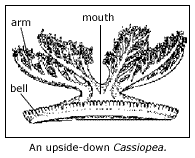

Phyllorhiza punctata

Cassiopea andromeda

Pennaria disticha

Carijoa riisei

Diadumene lineata
Cassiopea andromeda
 Upside-down
jellyfish
Upside-down
jellyfish
Phylum Cnidaria
Class Scyphozoa
Order Rhizostomeae
Family Cassiopeidae
Description
This jellyfish usually lies mouth upward on the bottom, in calm shallow
water, gently pulsating its bell to create water flow over it's arms.
The bell of Cassiopea is yellow-brown with
white or pale spots and streaks. The outstretched arms are also brownish
with extended frilly tentacles. Adults can grow to 30 cm in diameter.
They are often mistaken as sea anemones.
Habitat
Cassiopea are typically found in shallow
lagoons, intertidal sand or mud flats, and around mangroves. Cassiopea
feed on drifting zooplankton. Individuals also harbors photosynthetic
dinoflagellate algae that provides food to the jellyfish. The zooxanthellae
live in the tissues on the ventral surface of the jellyfish, and the jellyfish
sits on the bottom upside-down to provide sunlight to the symbiotic algae.
Distribution
 Hawaiian
Islands
Hawaiian
Islands
Throughout main Hawaiian Islands.
Native Range
Indo-Pacific
Present Distribution
Indo-Pacific and Hawaiian Islands
Mechanism of Introduction
Unintentional introduction, juvenile benthic stage in ships' hull-fouling
or pelagic stage in ballast water.
Impact
A nuisance species, which can sting people. Ecological impact unstudied.
Ecology
Feeding
Like other jellyfish, Cassiopea has stinging
cells or nematocysts in both its epidermis and gastrodermis, which is
used for protection and capturing food. A sting from Cassiopea
may result in skin welts, skin rash, itching, vomiting and skeletal pains
depending on the individuals sensitivity to the toxin of the nematocysts.
Reproduction
Basic cnidarian reproduction involves an asexually reproducing polyp stage,
alternating with a sexually reproducing medusoid stage, as described for
Phyllorhiza punctata. This jellyfish is dioecious;
an adult female jellyfish produces eggs and holds them until a male jellyfish
releases sperm into the water. The female uses her arms and tentacles
to gather sperm from the water to fertilize the eggs.
Remarks
Pacific basin Cassiopea are currently placed
in the one species C. andromeda (Hummelinck,
1968), but have been reported from Hawaii under two separate names, Cassiopea
medusa Light 1914 and Cassiopea mertensii
Brandt 1835. Cooke (1984) noted that these Cassiopea, with "their
pseudobenthic habits are the most improbable adult immigrants." As
C. medusa, Chu and Cutress (1954) note that
it was "common the year round in bays and salt-water canals."
Cutress (1961) considered it to be introduced from the Philippines by
ships as hull-fouling scyphistome to Pearl Harbor between 1941-1945. It
was restricted to Pearl Harbor until about 1950, when it appeared in Honolulu
Harbor and Ala Wai Canal. As C. mertensii
Brandt, Uchida (1970) reported it from "the sandy bottom at a depth
of 2 feet from Kaneohe Bay."
Under the name C. mertensii, it was previously
known from only several locations in the South Pacific Ocean, especially
the Caroline Islands. Cassiopea were seen
in the early 1990s in fishponds on Molokai and in fishponds in Waikaloa
area of the island of Hawaii .
References
Chu, G.W. and C.E. Cutress. 1954. Human dermatitis caused by marine organisms
in Hawaii. Proc. Haw. Acad. Sci. 1953-54: 9.
Cooke, W.J. 1984. New scyphozoan records for Hawaii: Anomalorhiza
shawi Light 1921 and Thysanostoma loriferum
(Ehrenberg 1835); with notes on several other rhizostomes. Proc. Biol.
Soc. Wash. 97: 583-588.
Cutress, C.E. 1961. [Comment on introduced jellyfish in Hawaii] p. 549,
in: Doty, M.S. 1961. Acanthophora, a possible
invader of the marine flora of Hawaii. Pac. Sci. 15(4): 547-552.
Hummelinck, P. W. 1968. Caribbean Scyphomedusae of the genus Cassiopea.
Studies on the Fauna of Curacao and other Caribbean Islands. 25: 1-57.
Uchida, T. 1970. Occurrence of a rhizostome medusa, Cassiopea
mertensii Brandt from the Hawaiian Islands. Annotat. Zool. Jap.
43:102-104.
© 2002 Hawaii Biological Survey, Bishop Museum
contact